Deformation Pattern of Well-Preserved High-Pressure Rocks (SE Syros, Cyclades)
Abstract
:1. Introduction

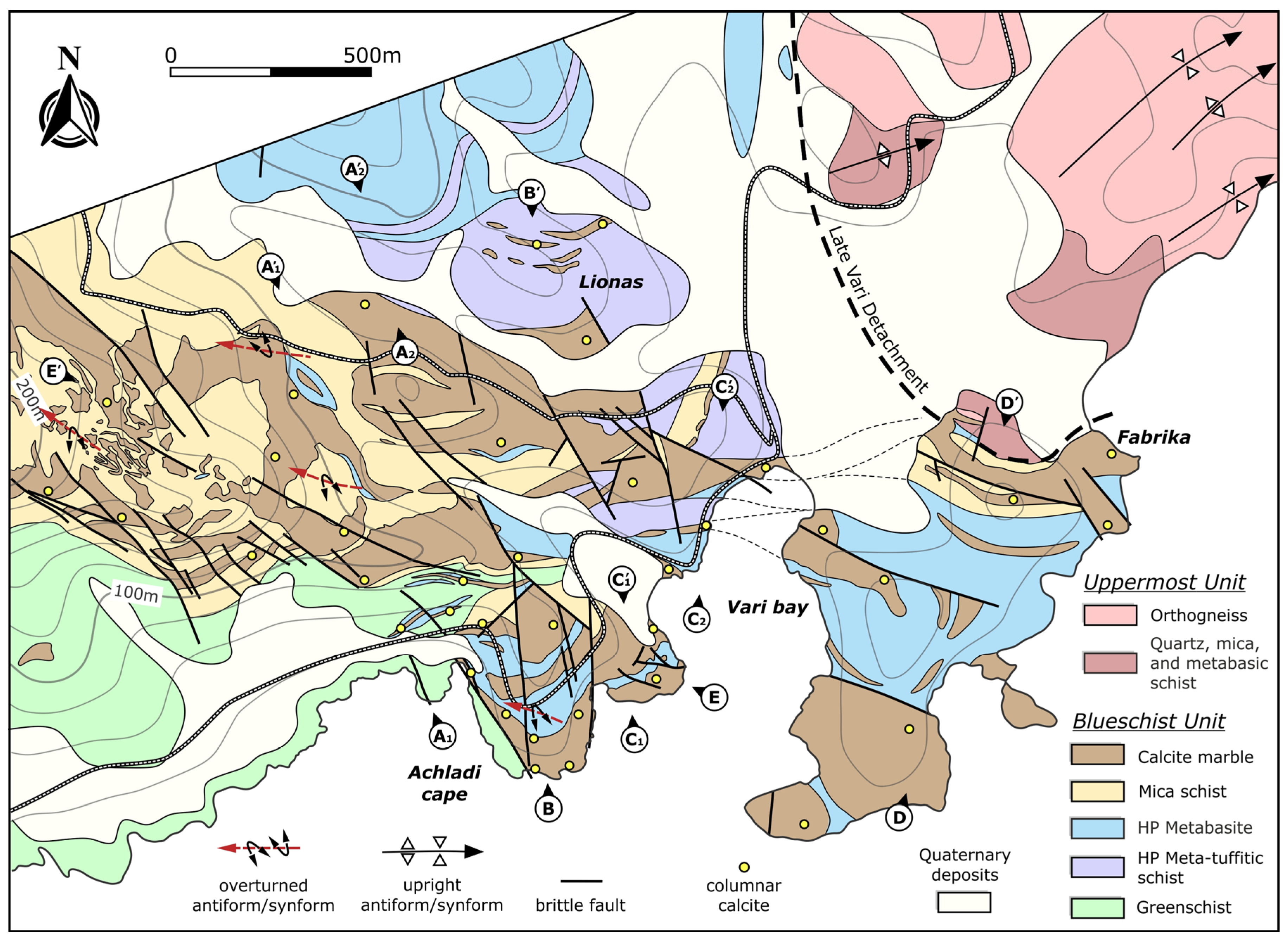

2. Geological and Structural Setting
3. Results
3.1. Mapping Results
3.2. Structural Analysis
4. Discussion
4.1. Structural Evolution of SE Syros
4.2. Is the Greenschist Overprint Related to the Formation of a Crustal-Scale Shear Zone?
5. Conclusions
Author Contributions
Funding
Data Availability Statement
Acknowledgments
Conflicts of Interest
References
- Okrusch, M.; Bröcker, M. Eclogites associated with high grade blueschists in the Cyclades archipelago, Greece: A review. Eur. J. Mineral. 1990, 2, 451–478. [Google Scholar] [CrossRef]
- Keiter, M.; Ballhaus, C.; Tomaschek, F. A New Geological Map of the Island of Syros (Aegean Sea, Greece): Implications for Lithostratigraphy and Structural History of the Cycladic Blueschist Unit; Geological Society of America: Boulder, CO, USA, 2011; Special Paper 481; 43p. [Google Scholar]
- Trotet, F.; Jolivet, L.; Vidal, O. Tectonometamorphic evolution of Syros and Sifnos islands (Cyclades, Greece). Tectonophysics 2001, 338, 179–206. [Google Scholar] [CrossRef]
- Rosenbaum, G.; Avigad, D.; Sánchez-Gómez, M. Coaxial flattening at deep levels of orogenic belts: Evidence from blueschists and eclogites on Syros and Sifnos (Cyclades, Greece). J. Struct. Geol. 2002, 24, 1451–1462. [Google Scholar] [CrossRef]
- Keiter, M.; Piepjohn, K.; Ballhaus, C.; Lagos, M.; Bode, M. Structural development of high-pressure metamorphic rocks on Syros island (Cyclades, Greece). J. Struct. Geol. 2004, 26, 1433–1445. [Google Scholar] [CrossRef]
- Schumacher, J.C.; Brady, J.B.; Cheney, J.T.; Tonnsen, R.R. Glaucophane-bearing marbles on Syros, Greece. J. Petrol. 2008, 49, 1667–1686. [Google Scholar] [CrossRef]
- Schumacher, J.C.; Brady, J.B.; Cheney, J.T. Metamorphic style and development of the blueschist- to eclogite-facies rocks, Cyclades, Greece. IOP Conf. Ser. Earth Environ. Sci. 2008, 2, 012017. [Google Scholar] [CrossRef]
- Soukis, K.; Stockli, D.F. Structural and thermochronometric evidence for multi-stage exhumation of Southern Syros, Cycladic islands, Greece. Tectonophysics 2013, 595, 148–164. [Google Scholar] [CrossRef]
- Laurent, V.; Jolivet, L.; Roche, V.; Augier, R.; Scaillet, S.; Cardello, G.L. Strain localization in a fossilized subduction channel: Insights from the Cycladic Blueschist Unit (Syros, Greece). Tectonophysics 2016, 672–673, 150–169. [Google Scholar] [CrossRef]
- Laurent, V.; Huet, B.; Labrousse, L.; Jolivet, L.; Monié, P.; Augier, R. Extraneous argon in high-pressure metamorphic rocks: Distribution, origin and transport in the Cycladic Blueschist Unit (Greece). Lithos 2017, 272–273, 315–335. [Google Scholar] [CrossRef]
- Aravadinou, E.; Xypolias, P. Evolution of a passive crustal-scale detachment (Syros, Aegean region): Insights from structural and petrofabric analyses in the hanging-wall. J. Struct. Geol. 2017, 103, 57–74. [Google Scholar] [CrossRef]
- Aravadinou, E.; Gerogiannis, N.; Xypolias, P. Development and passive exhumation of high-pressure shear zones (Blueschist Unit, Syros): Insights from quartz and columnar calcite microstructures. J. Struct. Geol. 2022, 159, 104607. [Google Scholar] [CrossRef]
- Kotowski, A.J.; Behr, W.M.; Cisneros, M.; Daniel, F.; Soukis, K.; Barnes, J.D.; Ortega Arroyo, D. Subduction, underplating, and return flow recorded in the Cycladic Blueschist Unit exposed on Syros, Greece. Tectonics 2022, 41, e2020TC006528. [Google Scholar] [CrossRef]
- Jolivet, L.; Brun, Ζ.J.P. Cenozoic geodynamic evolution of the Aegean. Int. J. Earth Sci. 2010, 99, 109–138. [Google Scholar] [CrossRef]
- Xypolias, P.; Kokkalas, S.; Skourlis, K. Upward extrusion and subsequent transpression as a possible mechanism for the exhumation of HP/LT rocks in Evia Island (Aegean Sea, Greece). J. Geodyn. 2003, 35, 303–332. [Google Scholar] [CrossRef]
- Xypolias, P.; Iliopoulos, I.; Chatzaras, V.; Kokkalas, S. Subduction- and exhumation-related structures in the Cycladic blueschists: Insights from south Evia island (Aegean region, Greece). Tectonics 2012, 31, TC2001. [Google Scholar] [CrossRef]
- Ring, U.; Glodny, J.; Will, T.; Thomson, S.N. An Oligocene extrusion wedge of blueschist-facies nappes on Evia, Aegean Sea, Greece: Implications for the early exhumation of high-pressure rocks. J. Geol. Soc. Lond. 2007, 164, 637–652. [Google Scholar] [CrossRef]
- Gerogiannis, N.; Xypolias, P.; Chatzaras, V.; Aravadinou, E.; Papapavlou, K. Deformation within the Cycladic subduction-exhumation channel: New insights from the enigmatic Makrotantalo nappe (Andros, Aegean). Int. J. Earth Sci. 2019, 108, 817–843. [Google Scholar] [CrossRef]
- Ring, U.; Pantazides, H.; Glodny, J.; Skelton, A. Forced return flow deep in the subduction channel, Syros, Greece. Tectonics 2020, 39, e2019TC005768. [Google Scholar] [CrossRef]
- Dürr, S. Das Attisch-Kykladische Kristallin. In Geologie von Griechenland; Jacobshagen, V., Ed.; Bornträger: Berlin, Germany, 1986; pp. 116–148. [Google Scholar]
- Uunk, B.; Brouwer, F.; de Paz-Álvarez, M.; van Zuilen, K.; Huybens, R.; van ’t Veera, R.; Wijbrans, J. Consistent detachment of supracrustal rocks from a fixed subduction depth in the Cyclades. Earth Planet. Sci. Lett. 2022, 584, 117479. [Google Scholar] [CrossRef]
- Laurent, V.; Scaillet, S.; Jolivet, L.; Augier, R.; Roche, V. 40Ar behaviour and exhumation dynamics in a subduction channel from multi-scale 40Ar/39Ar systematics in phengite. Geochim. Cosmochim. Acta 2021, 311, 141–173. [Google Scholar] [CrossRef]
- Gyomlai, T.; Agard, P.; Marschall, H.R.; Jolivet, L.; Gerdes, A. Metasomatism and deformation of block-in-matrix structures in Syros: The role of inheritance and fluid-rock interactions along the subduction interface. Lithos 2021, 386–387, 105996. [Google Scholar] [CrossRef]
- Gorce, J.S.; Caddick, M.J.; Baxter, E.F.; Dragovic, B.; Schumacher, J.C.; Bodnar, R.J.; Kendall, J.F. Insight into the early exhumation of the Cycladic Blueschist unit, Syros, Greece: Combined application of zoned garnet geochronology, thermodynamic modeling, and quartz elastic barometry. Geochem. Geophys. Geosyst. 2021, 22, e2021GC009716. [Google Scholar] [CrossRef]
- Bröcker, M.; Enders, M. Unusual bulk-rock compositions in eclogite-facies rocks from Syros and Tinos (Cyclades, Greece): Implications for U–Pb zircon geochronology. Chem. Geol. 2001, 175, 581–603. [Google Scholar] [CrossRef]
- Tomaschek, F.; Kennedy, A.; Villa, I.; Lagos, M.; Ballhaus, C. Zircons from Syros, Cyclades, Greece-Recrystallization and mobilization of zircon during high-pressure metamorphism. J. Petrol. 2003, 44, 1977–2002. [Google Scholar] [CrossRef]
- Cliff, R.A.; Bond, C.E.; Butler, R.W.H.; Dixon, J.E. Geochronological challenges posed by continuously developing tectonometamorphic systems: Insights from Rb–Sr mica ages from the Cycladic Blueschist Belt, Syros (Greece). J. Metamorph. Geol. 2017, 35, 197–211. [Google Scholar] [CrossRef]
- Skelton, A.; Peillod, A.; Glodny, J.; Klonowska, I.; Månbro, C.; Lodin, K.; Ring, U. Preservation of high-P rocks coupled to rock composition and the absence of metamorphic fluids. J. Metamorph. Geol. 2019, 37, 359–381. [Google Scholar] [CrossRef]
- Cisneros, M.; Barnes, J.D.; Behr, W.M.; Kotowski, A.J.; Stockli, D.F.; Soukis, K. Insights from elastic thermobarometry into exhumation of high-pressure metamorphic rocks from Syros, Greece. Solid Earth 2021, 12, 1335–1355. [Google Scholar] [CrossRef]
- Bröcker, M.; Baldwin, S.; Arkudas, R. The geological significance of 40Ar/39Ar and Rb-Sr white mica ages from Syros and Sifnos, Greece: A record of continuous (re) crystallization during exhumation? J. Metamorph. Geol. 2013, 31, 629–646. [Google Scholar] [CrossRef]
- Ridley, J. Tectonic Style, Strain History, and Fabric Development in a Blueschist Terrain, Syros, Greece. Ph.D. Thesis, Edinburgh University, Edinburgh, Scotland, 1982; 283p. [Google Scholar]
- Ridley, J.R. The significance of deformation associated with blueschist facies metamorphism on the Aegean island of Syros. Geol. Soc. Spec. Publ. 1984, 17, 545–550. [Google Scholar] [CrossRef]
- Philippon, M.; Brunn, J.P.; Gueydan, F. Tectonics of the Syros blueschists (Cyclades, Greece): From subduction to Aegean extension. Tectonics 2011, 30, TC4001. [Google Scholar] [CrossRef]
- Ridley, J. Arcuate lineation trends in a deep level, ductile thrust belt, Syros, Greece. Tectonophysics 1982, 88, 347–360. [Google Scholar] [CrossRef]
- Barr, H.M. Fluid-Rock Interactions during Blueschist and Greenschist Metamorphism in the Aegean Area of Greece. Ph.D. Thesis, Edinburgh University, Edinburgh, Scotland, 1989. [Google Scholar]
- Bond, C.E.; Butler, R.W.H.; Dixon, J.E. Co-axial horizontal stretching within extending orogens: The exhumation of HP rocks on Syros (Cyclades) revisited. Geol. Soc. Spec. Publ. 2007, 272, 203–222. [Google Scholar] [CrossRef]
- Glodny, J.; Ring, U. The Cycladic Blueschist Unit of the Hellenic subduction orogen: Protracted high-pressure metamorphism, decompression and reimbrication of a diachronous nappe stack. Earth. Sci. Rev. 2022, 224, 103883. [Google Scholar] [CrossRef]
- Brady, J.B.; Markley, M.J.; Schumacher, J.C.; Cheney, J.T.; Bianciardi, G.A. Aragonite pseudomorphs in high-pressure marbles of Syros, Greece. J. Struct. Geol. 2004, 26, 3–9. [Google Scholar] [CrossRef]
- Fleuty, M.J. The description of folds. Proc. Geol. Assoc. 1964, 75, 461–492. [Google Scholar] [CrossRef]
- Aravadinou, E.; Xypolias, P.; Chatzaras, V.; Iliopoulos, I.; Gerogiannis, N. Ductile nappe stacking and refolding in the Cycladic Blueschist Unit: Insights from Sifnos Island (south Aegean Sea). Int. J. Earth. Sci. 2016, 105, 2075–2096. [Google Scholar] [CrossRef]
- Gerogiannis, N.; Aravadinou, E.; Chatzaras, V.; Xypolias, P. Calcite pseudomorphs after aragonite: A tool to unravel the structural history of high-pressure marbles (Evia Island, Greece). J. Struct. Geol. 2021, 148, 104373. [Google Scholar] [CrossRef]
- Matthews, A.; Schliestedt, M. Evolution of the blueschist and greenschist-facies rocks of Sifnos, Cyclades, Greece. Contrib. Mineral. Petrol. 1984, 88, 150–163. [Google Scholar] [CrossRef]

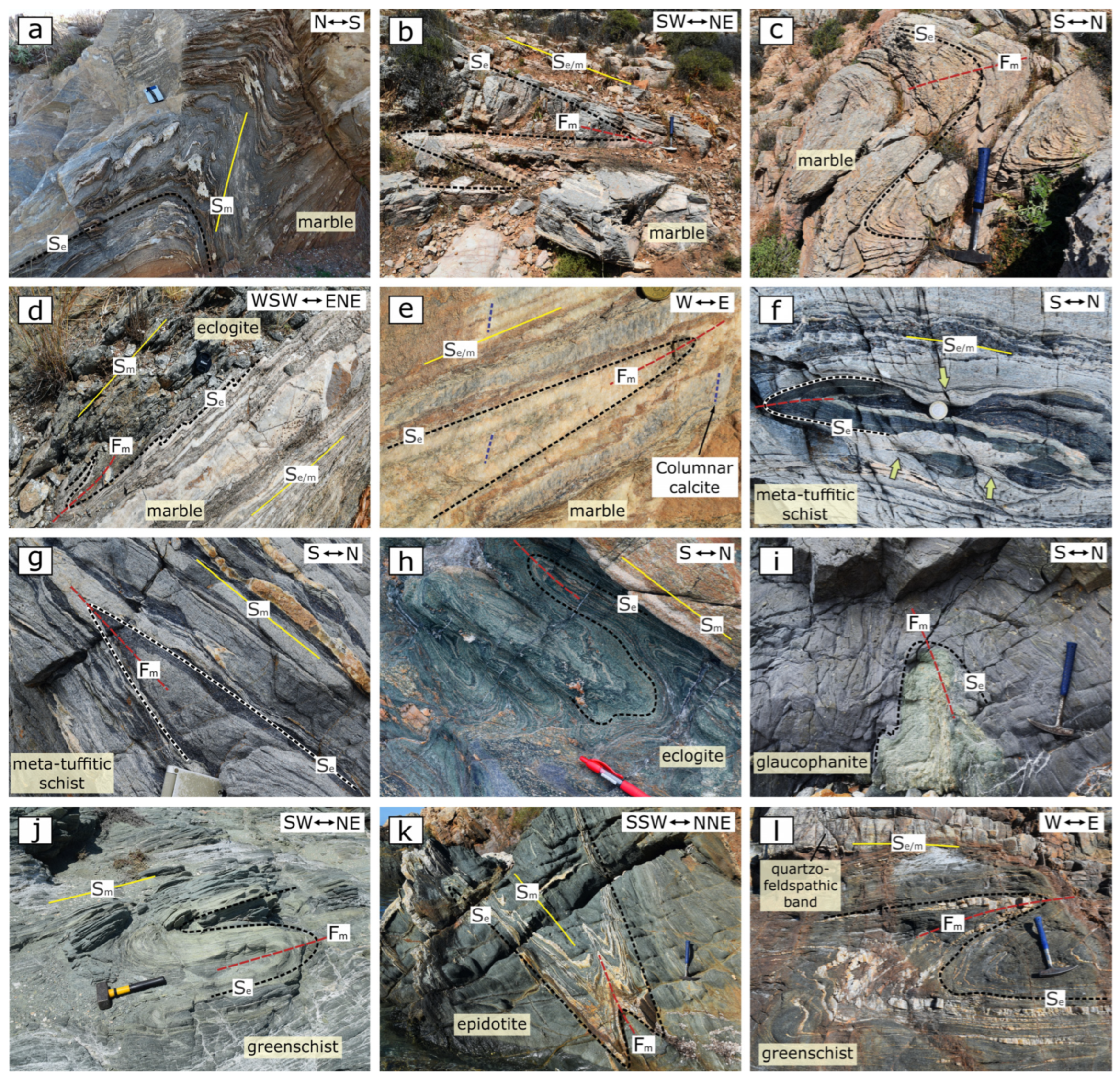

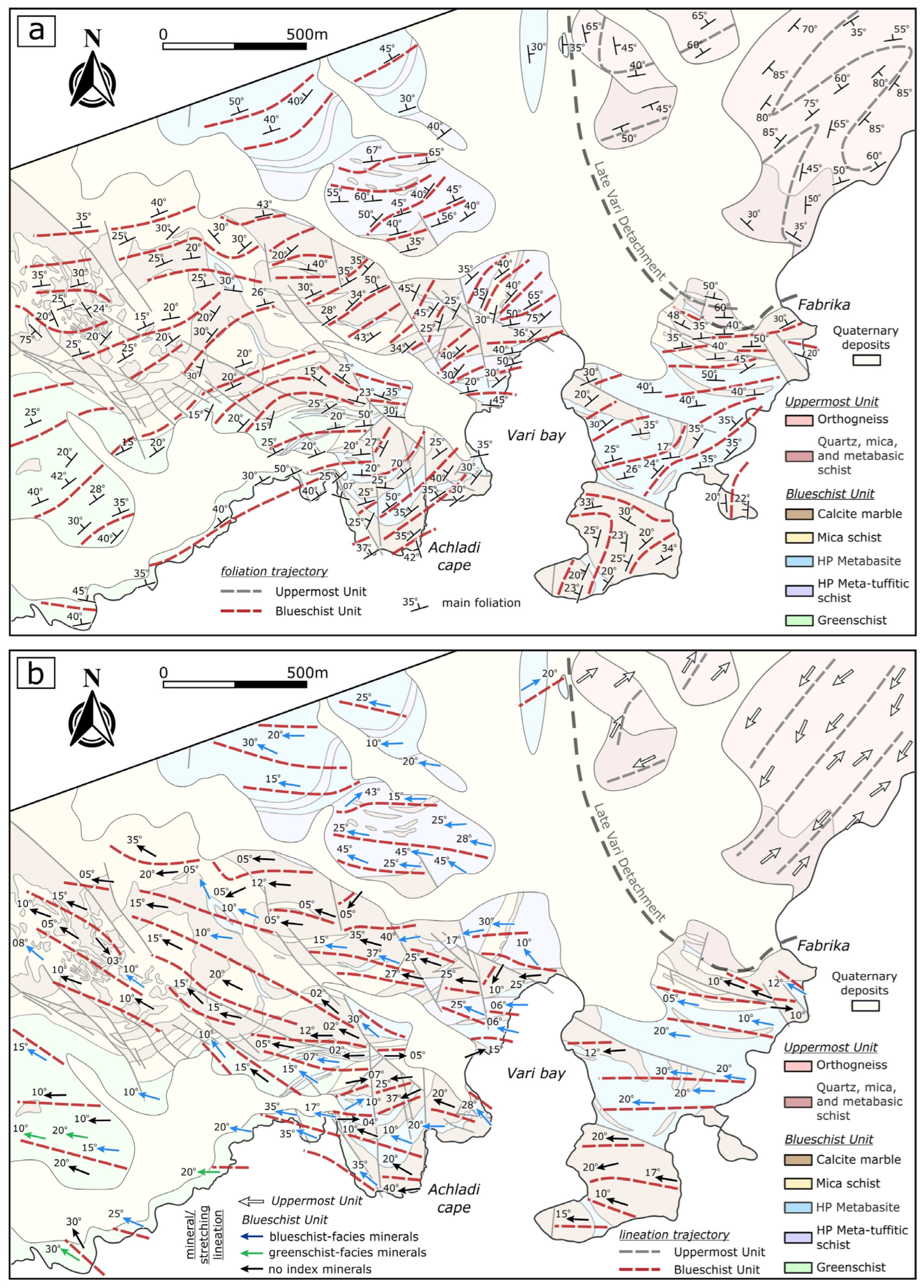
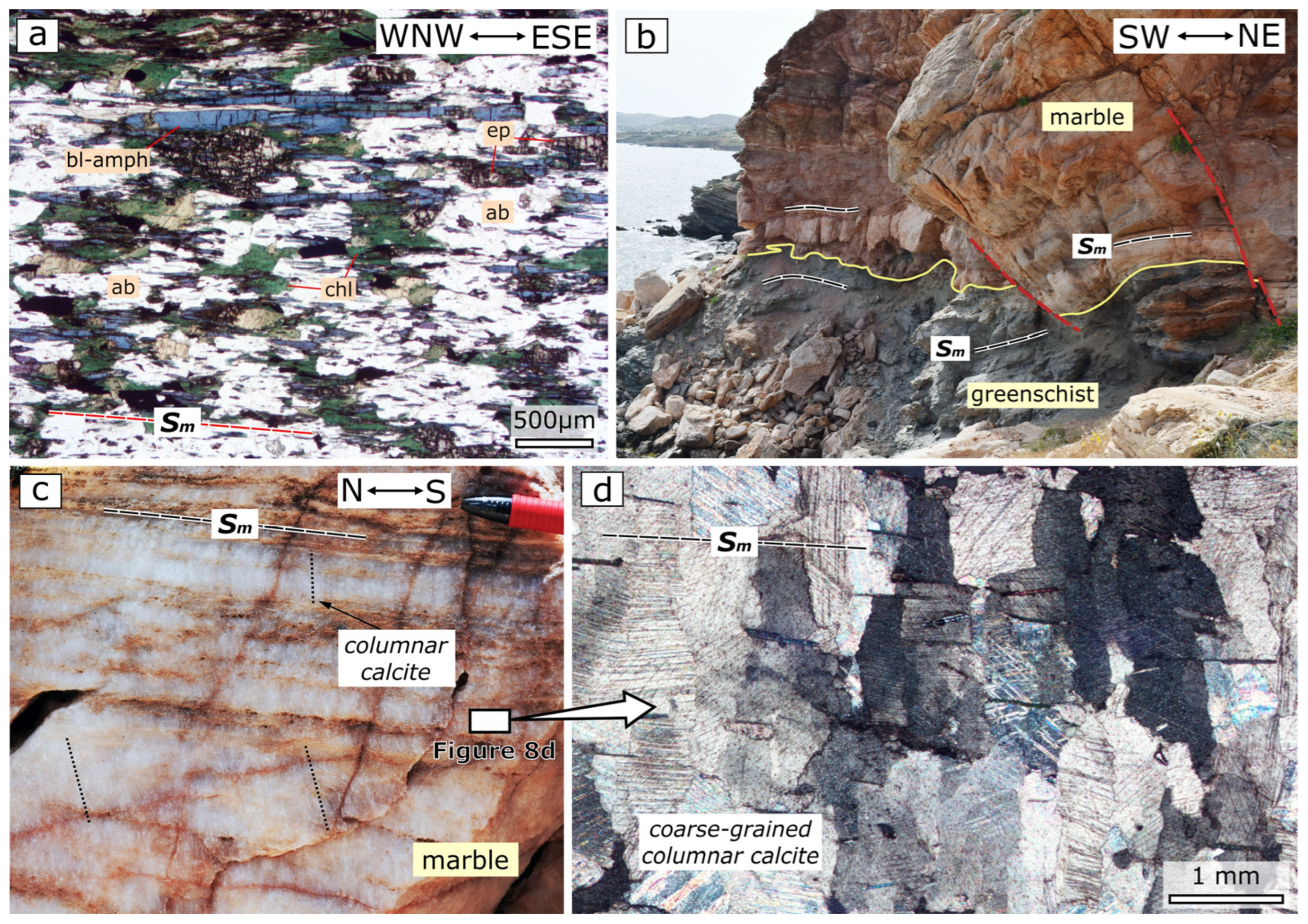

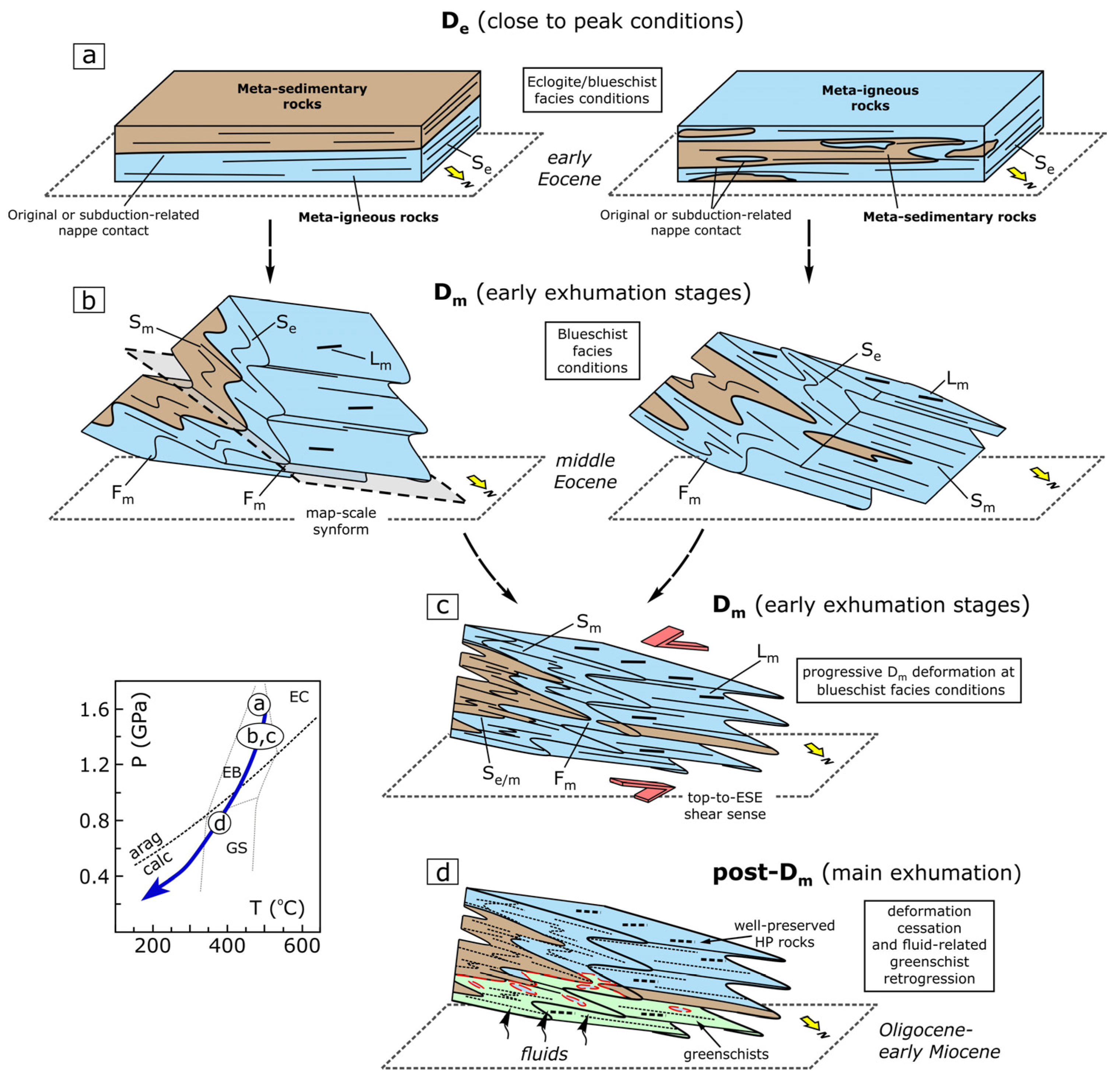
Disclaimer/Publisher’s Note: The statements, opinions and data contained in all publications are solely those of the individual author(s) and contributor(s) and not of MDPI and/or the editor(s). MDPI and/or the editor(s) disclaim responsibility for any injury to people or property resulting from any ideas, methods, instructions or products referred to in the content. |
© 2023 by the authors. Licensee MDPI, Basel, Switzerland. This article is an open access article distributed under the terms and conditions of the Creative Commons Attribution (CC BY) license (https://creativecommons.org/licenses/by/4.0/).
Share and Cite
Gerogiannis, N.; Aravadinou, E.; Xypolias, P. Deformation Pattern of Well-Preserved High-Pressure Rocks (SE Syros, Cyclades). Geosciences 2024, 14, 11. https://doi.org/10.3390/geosciences14010011
Gerogiannis N, Aravadinou E, Xypolias P. Deformation Pattern of Well-Preserved High-Pressure Rocks (SE Syros, Cyclades). Geosciences. 2024; 14(1):11. https://doi.org/10.3390/geosciences14010011
Chicago/Turabian StyleGerogiannis, Nikolaos, Eirini Aravadinou, and Paraskevas Xypolias. 2024. "Deformation Pattern of Well-Preserved High-Pressure Rocks (SE Syros, Cyclades)" Geosciences 14, no. 1: 11. https://doi.org/10.3390/geosciences14010011
APA StyleGerogiannis, N., Aravadinou, E., & Xypolias, P. (2024). Deformation Pattern of Well-Preserved High-Pressure Rocks (SE Syros, Cyclades). Geosciences, 14(1), 11. https://doi.org/10.3390/geosciences14010011








